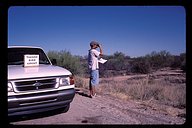|
Tucson Bird Count:
Results and Analysis
by Will Turner
Summary
The Tucson Bird Count has so far been a great success. Volunteers from
the Tucson community have counted birds at over 1000 sites throughout
the Tucson basin in spring surveys since 2001, and monitored birds in
20 parks on a quarterly basis. More than 215 species have been recorded
to date. Many studies have used TBC data to date (see the
TBC Press Room),
and TBC data have been used to inform land-use decisions.
Additional studies using TBC data are underway, and much more will be
done as other data sets (for example, land cover) are collected and
as the TBC continues through time. The TBC exists because of the efforts
of scores of committed birders, and the project's continuation into
the future will depend on their ongoing participation and the commitment
of individuals and institutions to put TBC results to good use.
The Tucson Bird Count currently consists of two programs.
The Route Program surveys hundreds of preselected sites across the Tucson
basin each spring, while the Park Monitoring Program provides year-round
data focused on particular parks, washes, neighborhoods, or other areas
of interest.
Route Program Results & Analysis, 2001-2002
In the Route Program (overview),
volunteers survey birds using 5-minute point counts at preselected sites
in and around Tucson. Data from this program let us create local distribution
maps for all species found, allow comparisons of bird communities in different
areas in and around Tucson, and track changes in Tucson-area birds through
time. In designing the Route Program, the study area is divided up into
a grid of 1 km2 cells, and one site is placed randomly within
each cell. Adjacent sites are linked together into "Routes",
with each route taking about one morning for a volunteer(s) to survey.
By all measures the TBC Route Program's first two years
have been a success. More than 80 birders participated each spring.
In 2001, observers surveyed 674 sites. In 2002, the count grew to 724 sites.
In these two years observers reported about 44,000 individual birds
representing 138 species (see current Species Summary Table).
The first scientific paper based on the Tucson Bird Count will be published in the journal
Landscape and Urban Planning in 2003, and more are in the works. Below are some
key findings presented in this first paper
(a preprint of the full paper can be viewed online).
2001 Species Distribution Maps
The large number of sites surveyed in the Route Program lets us make
Tucson-area distribution maps for bird species encountered. These maps
show some interesting and often distinct patterns, with many species
falling into one of a few general distribution types, discussed below.
Although more detailed analyses will follow, the fact that simply inspecting
species maps can reveal such pronounced patterns indicates just how
powerfully habitat dictates where birds reside in the Tucson area.
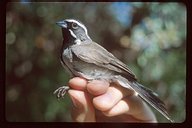 |
| Black-throated Sparrow |
Some species show donut-shaped distributions around Tucson. For example,
Gambel's Quail
is one of the most common species in the Tucson area, yet is almost completely
absent from most of Tucson proper. Many other native desert birds, for
example Ash-throated Flycatcher, Black-throated Sparrow, and others, show similarly donut-shaped
patterns.
 |
| Rock Dove |
In contrast, another group of species show the opposite pattern, reaching
their highest abundance near Tucson's urban core and decreasing toward
less-developed areas. These include 3 non-native species — Rock Dove,
European Starling, and House Sparrow — 3 species that have recently
expanded their ranges — Anna's Hummingbird, Great-tailed Grackle, and Inca Dove — and a few native species,
including Northern Mockingbird and Western Kingbird.
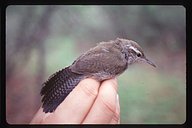 |
| Bewick's Wren |
Several bird species were observed most frequently in more wooded areas,
which in present-day Tucson are now generally restricted to the northeast
part of town. Each of the species showing this distribution pattern —
Phainopepla, Brown-crested Flycatcher, Bewick's Wren, Northern Cardinal — generally prefers more
densely vegetated streamside habitats in the arid southwestern United
States.
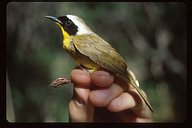 |
| Common Yellowthroat |
Last (and least, it turns out), are species characteristic of southwesten
riparian habitats. Due to decreased groundwater levels and direct removal
of forests, riparian habitats are currently less extensive than they had
been around Tucson as recently as 100 years ago. Only two riparian species
— Abert's Towhee, Yellow Warbler — were found at any
appreciable number of sites. Although neither species was found at more
than 15 sites, the distribution of these sites is informative: each lies
within meters of a major wash. Other riparian species showed up once or
twice — Common Yellowthroat and Song Sparrow — or not at all —
Summer Tanager and Yellow-breasted Chat.
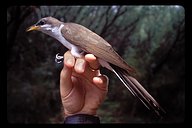 |
| Yellow-billed Cuckoo |
Yellow-billed Cuckoo, a native riparian species that is currently a candidate
for federal endangered status, arrives on its breeding grounds only well
after the TBC's spring count and thus is not expected in spring data.
It has been recorded during its breeding season in the TBC Park Monitoring
Program (see cuckoo),
although even these observations are relatively distant from urban Tucson.
Although current conditions for riparian species around Tucson are bleak,
several new attempts to restore riparian areas may provide more habitat
for these species in the future. In springs to come, the TBC will track
the impacts of these efforts on birds in riparian areas and surrounding
landscapes.
2001 Land Use Analysis
Distribution maps give us some insight into how birds respond to
development, but we can go a step further by using mapped information
on land use. I condensed various local zoning codes into 4 land use
classes: Commercial/Industrial (CI), High-density Residential (RH; min.
lot size < 8000 sq ft), Low-density Residential (RL), and Open Space
(OS; includes the large natural parks but not city parks or golf courses).
Using this map, I analyzed the TBC bird data to discern the land-use
class(es) that each species appeared to either excel or fare poorly
in (see Table 4 in the TBC Paper Preprint).
I also calculated a Sensitivity Index (SI) for each species, with higher
SI values indicating greater drop-offs in occurrence from preferred
land use class to other classes (greater sensitivity).
A few native species, such as Mourning Dove, were found equally often
in all land use classes (low SI of 0.08). Other species, such as Curve-billed
Thrasher (SI=0.24), and Gambel's Quail (SI=0.51),
were most common in the less-developed classes (OS and RL), but were
also found at higher development intensities (albeit less frequently).
In contrast, many native desert species were most common in OS or RL,
and rare or nonexistent at higher development intensities. These sensitive
species show higher SI values.
|
Table: Native Sonoran upland and xeroriparian
species most sensitive to Tucson development as indicated by zoning
code
|
| Species |
Most
Frequent
In
|
SI |
| Ash-throated Flycatcher |
OS |
1.29 |
| Bell's Vireo |
OS |
1.68 |
| Black-tailed Gnatcatcher |
OS |
1.05 |
| Black-throated Sparrow |
OS |
1.39 |
| Brown-crested Flycatcher |
OS/RL |
1.08 |
| Canyon Towhee |
OS |
1.47 |
| Canyon Wren |
OS |
1.70 |
| Gilded Flicker |
OS |
1.10 |
| Lucy's Warbler |
OS/RL |
1.06 |
| Phainopepla |
RL |
1.40 |
| Purple Martin |
OS/RL |
1.16 |
Future development is likely to affect most strongly those species that
prefer classes of lower development intensity (OS and RL) and also show
high SI values. This analysis reveals a list of 11 such species (table
at right), all of which depend on either upland Sonoran habitats or densely
vegetated washes. While it is safe to say that all of these species are
strongly influenced by development, this is not a complete list. In particular,
this analysis does not reveal sensitive species that either (1) are rare
or have already become rare and thus not enough data could be collected
to detect statistically significant results, or (2) depend on less-common
habitat types, such as riparian habitat (e.g., Abert's Towhee) or mixed Sonoran upland-grassland
(e.g., Rufous-winged Sparrow).
These findings have several implications. First, they
show the importance of natural habitats (OS in the above analysis) in
sustaining populations of many native bird species. Second, the finding
that some native species appear to persist in some developed areas offers
some hope that we may be able to successfully sustain birds near the
places we spend our lives. A small number of native species may be able
to persist in developed areas as they are currently structured. As for
the others, sustaining them will
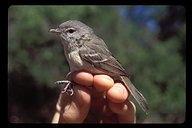 |
| Bell's Vireo |
require rethinking development practices. TBC results suggest that restoring
and retaining parcels of natural habitat in the metropolitan landscape
will be necessary to revive and sustain our native bird community. Additionally,
developed areas should retain as much of the structural and vegetative
character of natural habitats as possible over a substantial part of the
landscape.
Can birds and people coexist?
Why should we bother to sustain birds in urban/suburban areas? First,
the world is becoming more urban (percentage of humans worldwide in
urban areas passes 50% this decade, 70-80% in N America and Europe).
Simply put, the land left over is not enough to sustain the world's
biodiversity. Second, having nature near the places we live enhances
human quality of life. Third, bringing people in contact with nature
where they live, work, and play can increase appreciation for all nature,
wherever it may be. The Tucson Bird Count comes in again here: using
TBC and mapped data on human population from the US Census, we can actually
put numbers on the bird community that exists near where people live.
Of the roughly 520,000 people living in the area surveyed by the Route
Program, three out of four live where the number of bird species is
below the TBC average. If bird diversity is any indication of nature
in general, that translates to billions of people worldwide with reduced
opportunities to interact with and benefit from nature.
TBC results suggest that we can change this unfortunate
situation. We know that a few places, even in the heart of Tucson, appear
to help sustain diverse native bird communities. Ongoing work is investigating
TBC data in conjunction with high-resolution land cover maps to determine
what it is, exactly, about places with high bird diversity that makes
them special. Because "put a natural park the size of Saguaro East
in the middle of Tucson" is generally not an option, we need the
details. For example, what is the minimum area of upland Sonoran vegetation
required for Black-tailed Gnatcatchers to show up? Is clustered or dispersed
development better for sustaining bird species? What species are most
vulnerable to development, how can we make future development easier
on them, and what important areas should we avoid developing entirely?
The Tucson Bird Count's Route Program will help answer these and other
important questions.
Park Monitoring Program Results, 2001-2002
The Tucson Bird Count's second program is the Park Monitoring
Program, in which volunteers select a park, wash, neighborhood, or other
area of bird/birding interest to monitor four times per year. The Park
Monitoring Program serves a number of uses, including (1) providing
initial bird inventory data on parks for which no rigorous inventory
has been done; (2) collecting data at more focused spatial scales than
is possible in the more extensive Route Program; (3) monitoring changes
in a park's bird community through time as the park and surrounding
landscape change or as management/restoration actions are taken; (4)
surveying Tucson's bird community year-round. At the time of this writing
individuals and groups have adopted 13 parks and recorded data on 165 species.
Be a part of the Tucson Bird Count
The TBC is important to science and conservation, is vital to Tucson's
livability for both birds and people, and is unprecedented worldwide.
The most important part of the TBC, bar none, is the committed individuals
who participate in the counts. To find out how you can help, contact
us or see the TBC's Participation
Page.
|
